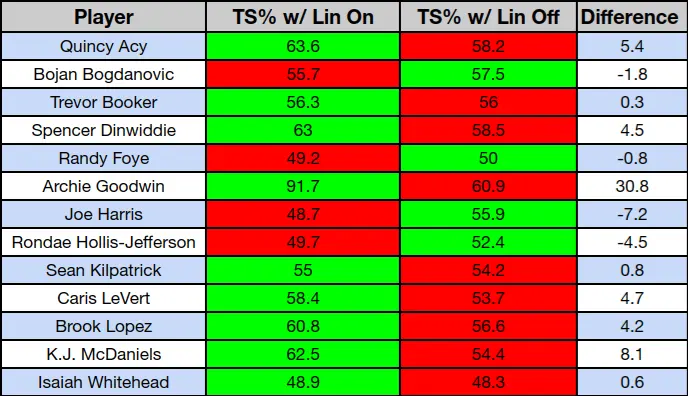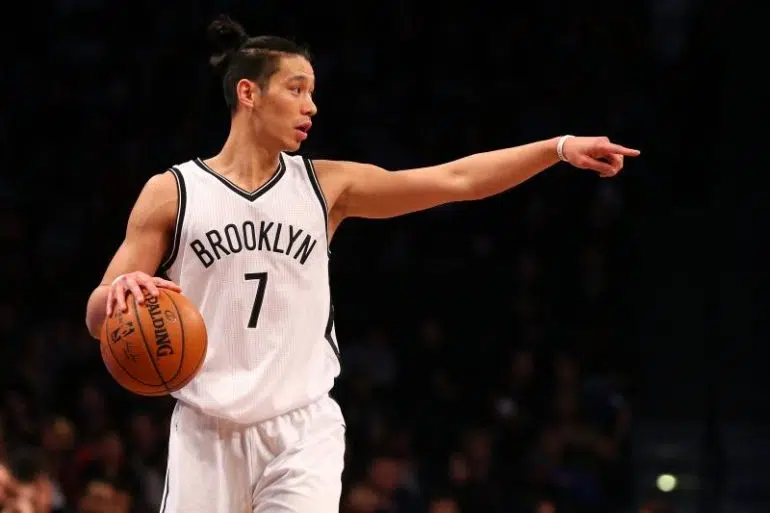Jeremy Lin is going to be the catalyst of the Brooklyn Nets’ offense this season, but how exactly does he impact it?
The league has come a long way since the 1960s and ‘70s when big men dominated, and we can thank Michael Jordan and the Chicago Bulls for initiating the changing of the guard (pun not intended). Nowadays, guys like Stephen Curry, Russell Westbrook, and James Harden dominate so much of the game because of their ability to demand attention. Not only does that generate more buckets for them, but it also opens things up for their teammates.
The Brooklyn Nets don’t have a MVP-caliber floor general, but Jeremy Lin is more than capable of occupying the point guard slot on a competitive team, which is a nice consolation prize for a franchise that finished in the league’s basement. We didn’t get to see much of it last year because the Harvard alum suited up for just 36 games thanks to various hamstring issues, but the Nets felt his impact whenever he stepped on the court. In 24.5 minutes a night, Lin averaged 14.5 points and 5.1 rebounds while shooting 43.8 percent overall. The Nets were 13-23 in contests he played.
His impact wasn’t intoxicating, but it was something. Brooklyn put up 105.6 points per 100 possessions with Lin on the court, compared to 104.1 when he sat. There are, of course, other factors that play into how the team performs. The talent of the roster as a whole directly impacts how a team guards the opposing point guard. Golden State is the most extreme example because teams can’t throw multiple defenders at Stephen Curry when he can kick the ball to Kevin Durant, Klay Thompson, Draymond Green or someone else. Conversely, it’s not much safer letting someone guard Steph one-on-one because, well, he’s a wizard with the basketball and makes All-Defense guys look silly. For the Warriors, it’s an incredible problem to have. The Nets don’t have that.
Brooklyn averaged 105.8 points a night last year (12th) but was 28th in efficiency. Their leading scorer was Brook Lopez at 20.5 points, but he’s no longer with the team. (I’m not crying, you’re crying!) D’Angelo Russell is going to help with the scoring, as well as Sean Kilpatrick and anyone else who wants to step up. Lin, however, is going to be the epicenter.
He’ll be the Nets’ starting point guard come opening night. Russell, who played a ton of the one with the Los Angeles Lakers, said it’s easier for him to play at shooting guard, and it’s obvious that he’s better suited as a go-to scorer and secondary ball handler. Brooklyn’s system features a ton of motion and ball movement. That is because of Kenny Atkinson, who’s a product of the Gregg Popovich coaching tree. He teaches unselfishness because it’s a good habit, but also because the Nets don’t have the talent to rely on one person to get them buckets consistently. Teams like the Cavaliers can do so because of LeBron James.
Lin’s First Season in Brooklyn
Jeremy Lin did an excellent job as the orchestrator. For the first time since Linsanity, he was able to fully command an offense. In Houston, it was James Harden’s team. In Los Angeles, Lin was the puppeteer, but the weapons paled in comparison to what’s in Brooklyn. Most recently, he played backup to Kemba Walker in Charlotte, a role that he excelled in because he was the go-to guy for that second unit. Now back in the driver’s seat, it’s Lin’s job to put everyone before himself. And that he did.
He assisted on 35.5 percent of his teammates’ field goals, a number that’s only been eclipsed once in his career, and that came during Linsanity. Not only were the guys hitting more shots; Lin was able to display his tremendous basketball IQ, while also taking risks some guards would be hesitant to make. When a player is the leader of an inferior team, failing to connect on the home run play doesn’t mean much because it’s not going to break anything.
Putting aside the benefits for you, it makes the defense act differently. When you’re defending, and you know a player is going to play it safe, you can feed on that and force him to react to you. The great players influence their defenders, not the other way around. While Jeremy Lin isn’t a top-tier point guard, he has these qualities to a lesser degree. When he puts his head down and attacks, the help has to come because he’s too reliable of a finisher, and that opens up other opportunities for his teammates.
Visualizing Lin’s Impact
To illustrate Lin’s impact, I created this chart (data courtesy of NBA Wowy):

I’m not big on analytics, but I do like to use them from time to time. The chart above is more cut-and-dry than any I’ve ever seen in a science or math class, and its idea is simple: the difference in shooting when Jeremy Lin is on the court, compared to him being off.
True shooting percentage, according to Basketball Reference, is “a measure of shooting efficiency that takes into account 2-point field goals, 3-point field goals, and free throws.” It’s an aggregate shooting metric.
When I made this chart, I didn’t look into the future so carefully. The 13 players I selected had no criteria aside from me being subjective. However, all of them averaged at least 15 minutes a night this year with Brooklyn — albeit, not all came alongside Lin. (What I’m really trying to say here is that this list is far from perfect, and I had no idea it would influence this post. Now that we’re here, though, I’m happy it did.)
The first thing that jumps out is Archie Goodwin being 30.8 percentage points better with Lin on the court. However, there’s a tiny sample size backing that. Second, for the most part, Lin makes his guys better — that’s how it’s supposed to be. All but four guys see a drop with him on the court, and Joe Harris and Rondae Hollis-Jefferson are the only two who see significant drops.
That’s intriguing to me. Harris is someone whose entire offense is contingent on others helping him out; he needs bigs to set screens, and guards to feed him the ball. RHJ doesn’t surprise me much because he’d probably struggle with Magic Johnson feeding him the rock. Synergy considers any shot where the defender is more than six feet away “wide open.” Hollis-Jefferson had 76 shots qualify for that, and he connected on 35.5 percent of them — thirty-five point five. For comparison, Gordon Hayward buried 45.9 percent of those same shots. He’s a far better offensive player, but Utah struggled to put points on the board, and that, theoretically, makes them tougher to guard.
Everyone who improved plays off the ball, but it’s the extent that varies. Brook Lopez, Quincy Acy and Trevor Booker are frontcourt players and get easy shots because of the point guard’s penetration. Lin drives, attracts the defense and makes the play he feels is best. With the wings, it gets tricky.
Looking Ahead
Sean Kilpatrick, Caris LeVert, Isaiah Whitehead and Spencer Dinwiddie have all spent time as the ball-handler, but they’re most effective creating for themselves at the two. The same is going to be true with Russell this year. Last season, with Lin on the floor, the guys above didn’t get the same attention with him off, which means more one-on-one coverage because the defense is off-balance. When that happens, it’s easier to get into the paint. If that doesn’t happen, they may be left open entirely.
The Brooklyn Nets are going to be a solid offense next season, and Jeremy Lin’s going to have total control of it. He may not be an All-Star, but that doesn’t mean he won’t make an impact. The talent pool at point guard has so much depth that Lin would have to post an absurd stat line, and I don’t see that happening. Regardless, 16 points and seven assists a night is nothing to scoff at, and he won’t need to shoulder a huge load because of the weapons supporting him.

